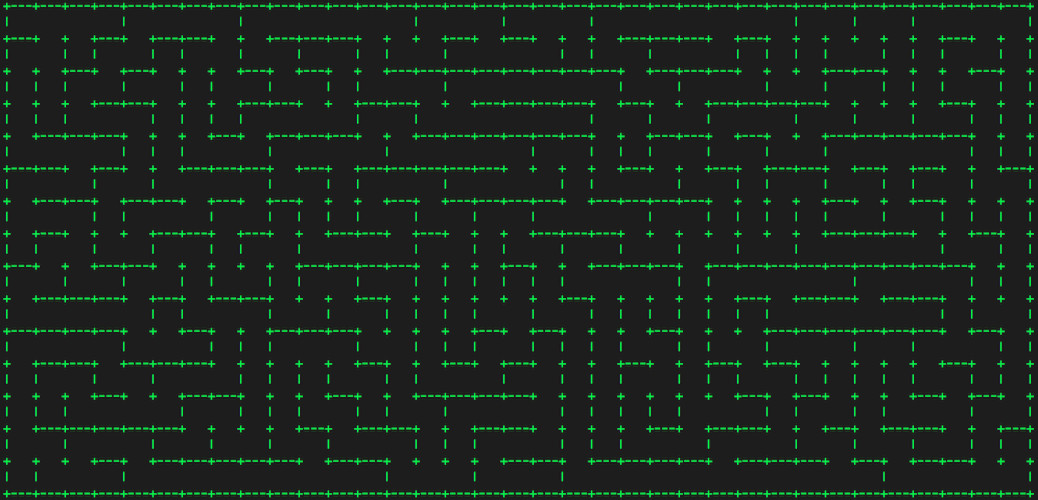Mazes – from Ruby to Python

Mazes for Programmers is a great book. Definitely one of the greatest books of all time! (about mazes:-)
The book has great code for mazes but unfortunately, for me, the code is in Ruby and I am not yet ready to start coding with Ruby.
But I feared not!
I like Python and Xtend, so I tend to prefer them when coding. And since the Mazes for Programmers is about algorithms and techniques, not about Ruby, I decided to translate some of the code to Python.
I chose base classes of Cell and Grid and two algorithms: Binary Tree and Recursive Backtracker for translation and I discovered that Ruby is an easy language to read and it’s similar to Python in many ways
Below is the translated Python code (the original Ruby code is found from here). I did some modifications, so the Python code is not exactly as the Ruby code.
(edit 12.09.2015: Code below is the latest code and has more than two algorithms. It reflects latest version)
#!/usr/bin/env python
#Some mazes classes translated from Ruby
#from book "Mazes for Programmers" by Jamis Buck.
#https://pragprog.com/book/jbmaze/mazes-for-programmers
#
#Includes modifications.
#
#Execute this and you see mazes.
import random
class Cell:
def __init__(self,row,column):
self.row=row
self.column=column
self.north=None
self.east=None
self.south=None
self.west=None
self.links=dict()
def link(self,cell,bidi=True):
self.links[cell] = True
if bidi==True:
cell.link(self,False)
return self
def unlink(self,cell,bidi=True):
try:
del self.links[cell]
except KeyError:
pass
if bidi==True:
cell.unlink(self, false)
return self
def getLinks(self):
return self.links.keys()
def linked(self,cell):
return self.links.has_key(cell)
def neighbors(self):
neighborsList = []
if self.north:
neighborsList.append(self.north)
if self.east:
neighborsList.append(self.east)
if self.south:
neighborsList.append(self.south)
if self.west:
neighborsList.append(self.west)
return neighborsList
def hasNeighbor(self,direction):
if direction=="north" and self.linked(self.north):
return True
if direction=="east" and self.linked(self.east):
return True
if direction=="south" and self.linked(self.south):
return True
if direction=="west" and self.linked(self.west):
return True
return False
#return Distances from this cell to all other cells
def getDistances(self):
distances=Distances(self)
frontier=[]
frontier.append(self)
while len(frontier)>0:
newFrontier=[]
for cell in frontier:
for linked in cell.getLinks():
if distances.getDistanceTo(linked) is None:
dist=distances.getDistanceTo(cell)
distances.setDistanceTo(linked,dist+1)
newFrontier.append(linked)
frontier=newFrontier
return distances
def __str__(self):
output="Cell[%d,%d], Linked neighbors: " % (self.row,self.column)
if self.linked(self.north):
output=output+" North: YES "
else:
output=output+" North: NO "
if self.linked(self.east):
output=output+" East: YES "
else:
output=output+" East: NO "
if self.linked(self.south):
output=output+" South: YES "
else:
output=output+" South: NO "
if self.linked(self.west):
output=output+" West: YES "
else:
output=output+" West: NO "
return output
class Distances:
def __init__(self,rootCell):
self.rootCell=rootCell
self.cells=dict()
self.cells[self.rootCell]=0
def getDistanceTo(self,cell):
return self.cells.get(cell,None)
def setDistanceTo(self,cell,distance):
self.cells[cell]=distance
def getCells(self):
return self.cells.keys()
def isPartOfPath(self,cell):
return self.cells.has_key(cell)
def __len__(self):
return len(self.cells.keys())
def pathTo(self,goal):
current=goal
breadcrumbs = Distances(self.rootCell)
breadcrumbs.setDistanceTo(current,self.cells[current])
while current is not self.rootCell:
for neighbor in current.getLinks():
if self.cells[neighbor] < self.cells[current]:
breadcrumbs.setDistanceTo(neighbor,self.cells[neighbor])
current=neighbor
break
return breadcrumbs
class Grid:
def __init__(self,rows,columns,cellClass=Cell):
self.CellClass=cellClass
self.rows=rows
self.columns=columns
self.grid=self.prepareGrid()
self.distances=None
self.configureCells()
def prepareGrid(self):
rowList=[]
i=0
j=0
for i in range(self.rows):
columnList=[]
for j in range(self.columns):
columnList.append(self.CellClass(i,j))
rowList.append(columnList)
return rowList
def eachRow(self):
for row in self.grid:
yield row
def eachCell(self):
for row in self.grid:
for cell in row:
yield cell
def configureCells(self):
for cell in self.eachCell():
row=cell.row
col=cell.column
cell.north=self.getNeighbor(row-1,col)
cell.east=self.getNeighbor(row,col+1)
cell.south=self.getNeighbor(row+1,col)
cell.west=self.getNeighbor(row,col-1)
def getCell(self,row,column):
return self.grid[row][column]
def getNeighbor(self,row,column):
if not (0 <= row < self.rows):
return None
if not (0 <= column < self.columns):
return None
return self.grid[row][column]
def size(self):
return self.rows*self.columns
def randomCell(self):
row=random.randint(0, self.rows-1)
column=self.grid
column = random.randint(0,len(self.grid[row])-1)
return self.grid[row][column]
def contentsOf(self,cell):
return " "
def __str__(self):
return self.asciiStr()
def unicodeStr(self):
pass
def asciiStr(self):
output = "+" + "---+" * self.columns + "\n"
for row in self.eachRow():
top = "|"
bottom = "+"
for cell in row:
if not cell:
cell=Cell(-1,-1)
body = "%s" % self.contentsOf(cell)
if cell.linked(cell.east):
east_boundary=" "
else:
east_boundary="|"
top = top+ body + east_boundary
if cell.linked(cell.south):
south_boundary=" "
else:
south_boundary="---"
corner = "+"
bottom =bottom+ south_boundary+ corner
output=output+top+"\n"
output=output+bottom+"\n"
return output
class DistanceGrid(Grid):
#def __init__(self,rows,columns,cellClass=Cell):
# super(Grid, self).__init__(rows,columns,cellClass)
def contentsOf(self,cell):
if self.distances.getDistanceTo(cell) is not None and self.distances.getDistanceTo(cell) is not None:
n=self.distances.getDistanceTo(cell)
return "%03d" % n
else:
return " " #super(Grid, self).contentsOf(cell)
def initBinaryTreeMaze(grid):
for cell in grid.eachCell():
neighbors=[]
if cell.north:
neighbors.append(cell.north)
if cell.east:
neighbors.append(cell.east)
if len(neighbors)>0:
if len(neighbors)==1:
ind=0
else:
ind=random.randint(0,len(neighbors)-1)
neighbor=neighbors[ind]
if neighbor:
cell.link(neighbor)
return grid
def initRecursiveBacktrackerMaze(grid):
stack = []
stack.append(grid.randomCell())
while len(stack)>0:
current = stack[-1]
neighbors=[]
for n in current.neighbors():
if len(n.getLinks())==0:
neighbors.append(n)
if len(neighbors)==0:
stack.pop()
else:
neighbor = random.choice(neighbors)
current.link(neighbor)
stack.append(neighbor)
return grid
def initSidewinderMaze(grid):
tf=[True,False]
for row in grid.eachRow():
run=[]
for cell in row:
run.append(cell)
at_eastern_boundary = (cell.east == None)
at_northern_boundary = (cell.north == None)
#note: ruby: 0 == True
should_close_out =at_eastern_boundary or ( at_northern_boundary==False and random.choice(tf) == True)
if should_close_out == True:
member = random.choice(run)
if member.north:
member.link(member.north)
run=[]
else:
cell.link(cell.east)
return grid
#====================
def initRecursiveBacktrackerMaze2(grid):
rbWalkFrom(grid.randomCell())
return grid
def rbWalkFrom(cell):
shuffledNeighbors=random.sample(cell.neighbors(),len(cell.neighbors()))
for neighbor in shuffledNeighbors:
if len(neighbor.getLinks())==0:
cell.link(neighbor)
rbWalkFrom(neighbor)
if __name__ == "__main__":
rows,columns=10,10
grid=Grid(rows,columns)
grid=initBinaryTreeMaze(grid)
print("Binary Tree Maze:")
print(grid)
grid=DistanceGrid(rows,columns)
grid=initRecursiveBacktrackerMaze(grid)
startRow=0#random.randint(0, rows-1)
startColumn=0#random.randint(0, columns-1)
start = grid.getCell(startRow,startColumn)
goalRow=rows-1#random.randint(0, rows-1)
goalColumn=columns-1#random.randint(0, columns-1)
goal= grid.getCell(goalRow,goalColumn)
distances = start.getDistances()
grid.distances = distances.pathTo(goal)
print("Recursive Backtracker Maze:")
print("Start: ", start)
print("Goal: ", goal)
print(grid)
grid=Grid(rows,columns)
grid=initSidewinderMaze(grid)
print("Sidewinder Maze:")
print(grid)